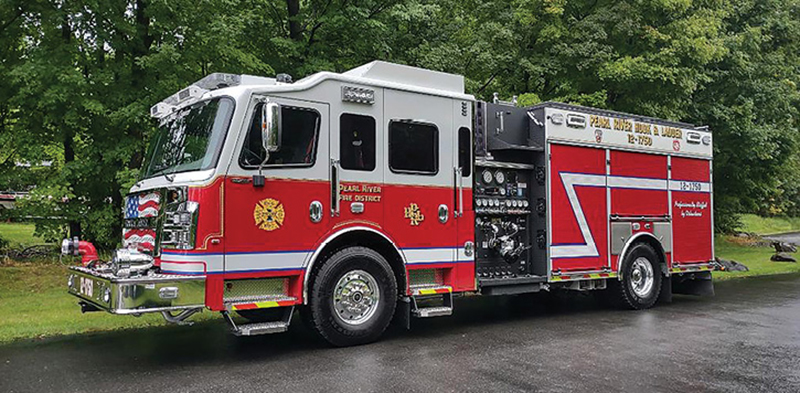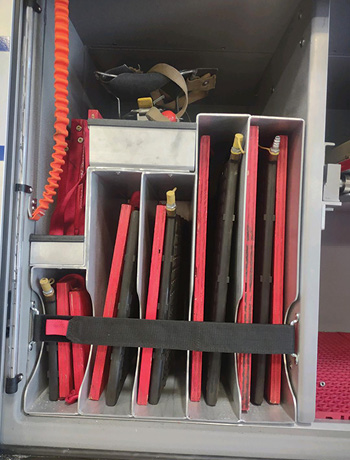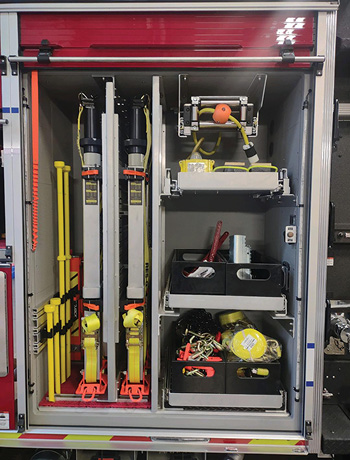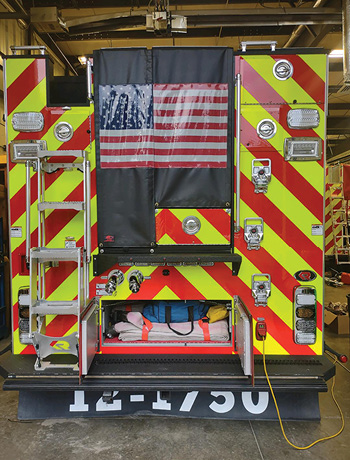The Pearl River Fire Department is an all-volunteer department comprising Hook and Ladder Co. #1 and Excelsior Engine Company. Both provide protection to a 4.5-square-mile fire district in Rockland County, New York.

Both companies’ response district covers numerous strip shopping centers, taxpayers, a 22-story office building, a Pfizer manufacturing plant, Route 304, and parts of the Palisades Parkway. The fire district also protects large areas of residences. According to Ex Chief and Commissioner Don Arterburn, “The fire district operates with an apparatus replacement program that has engines being replaced at the 20- to 25-year mark and aerials on a 15- to 20-year range. It all depends on age and maintenance and, of course, our budget.”
The department was beginning the process to replace a 23-year-old pumper that was starting to show its age and started working on specs about two years ago. “We looked at several manufacturers but chose Rosenbauer since we purchased a 2017 78-foot Rosenbauer quint about six years ago as well as our sister company purchasing a rescue-pumper back in 2014,” says Arterburn. “Our fire district was satisfied with the operation of the previous Rosenbauer apparatus as well as the local dealer in the area, Garrison Fire & Rescue. So, it was really a no-brainer to go with Rosenbauer again.”

1 Pearl River’s 2023 Rosenbauer rescue-pumper built with seating for six on a Commander cab and chassis. (Photos courtesy of Garrison Fire & Rescue.)

2 eDRAULIC extrication equipment and Milwaukee battery-powered saws and hand tools.
For this new pumper, the department designed the rig with a rescue body for added compartment space and to allow it to be a multifunctional vehicle, especially during the daytime hours when staffing is scarce, according to Arterburn. “We were also able to purchase the apparatus through the HGAC purchasing consortium, so we didn’t have to go to bid, which worked out well for us,” he adds.
The committee designed the body with 24-inch-deep compartments all around, a low hosebed to make it easier for firefighters to stretch lines off the back, a Will-Burt light mast for scene safety—the department operates on the parkway and some other major roadways—coffin compartments for extra compartmentation, a 10-kW hydraulic generator, a 700-gallon polypropylene water tank, and a diamond plate hosebed cover. Arterburn says, “We went with a six-man cab with fold-up seats in the rear for more space. A lot more thinking went into this vehicle when we wrote the specs and design than when we designed the previous 23-year-old pumper.” Hose inventory on the new rig is 800 feet of large-diameter hose, 400 feet of 3-inch hose, 400 feet of 2½-inch hose, 600 feet of 1¾-inch hose, and two speedlays of 200 feet each of 1¾- and 2½-inch hose.
“During the build process, we visited the factory twice,” says Arterburn, “for a preconstruction meeting and final inspection. It was built at Rosenbauer’s Minnesota plant. The workers and engineers were very professional during the time of our visits, and engineering was great with the final build. Change orders were minimal, mostly our problems we worked through. All of our questions and concerns were dealt with at the factory and corrected.” He adds, “The finish on the vehicle was great as well. Our committee and fire district were pleased with the final build. The delivery took approximately 28 months, which for today’s standards was not bad at all.”
All tool mounting was completed at Garrison Fire & Rescue. The department decided on battery-powered saws and hand tools, fans, a complete HURST Jaws of Life eDRAULIC system with cutters and spreaders, as well as air bags, rescue struts, and the normal complement of forcible entry tools. The tool layout was such that no space was wasted, and the department has compartment space for future growth.

3 The rescue-pumper’s air bag compartment.

4 Rescue strut storage on the new rescue-pumper.

5 The rig’s low hosebed and scene lights.

6 Forcible entry tools and hand lights.
Pearl River Hook and Ladder Fire Company #1 Rosenbauer Pumper
|
The Pearl River Fire Department wanted a fully functional, multipurpose engine. It designed a pumper with a rescue body to hold not only the normal amount of hose and engine company fittings and tools but expanded the design to perform as a rescue-pumper to better address the target hazards present in its response district. Department members took into consideration the equipment that they wanted to carry, updating it to battery-powered fans, saws, extrication tools, and hand tools. The end result also gave them more compartment space for future use.
As I have mentioned in numerous columns, always look at the target hazards in your response district as well as mutual-aid areas when you design a new apparatus—no matter what it is. Planning compartment space for the purchase of tools in the future is another item you should be thinking about. You don’t want to overload the apparatus. It might be too late to expand in the future. Whatever the case may be, it’s never too early for proper planning for a future apparatus purchase.
BOB VACCARO has more than 40 years of fire service experience. He is a former chief of the Deer Park (NY) Fire Department. Vaccaro has also worked for the Insurance Services Office, the New York Fire Patrol, and several major commercial insurance companies as a senior loss-control consultant. He is a life member of the IAFC.

